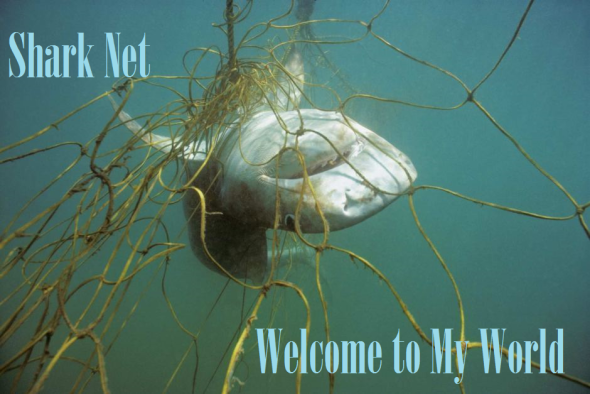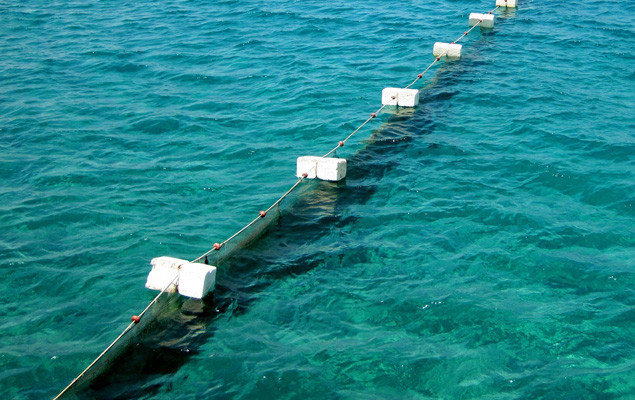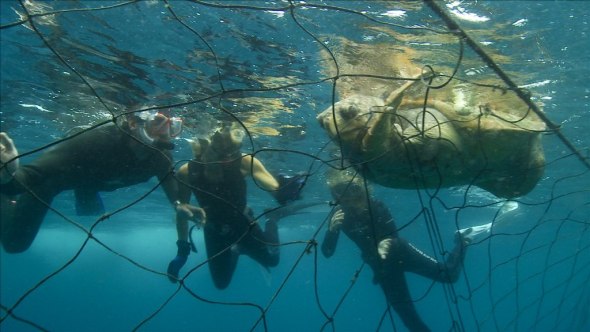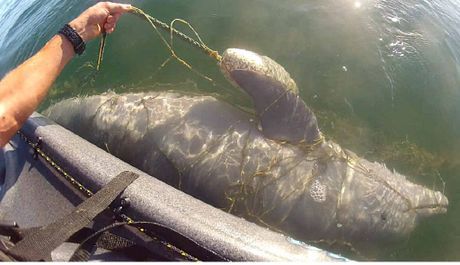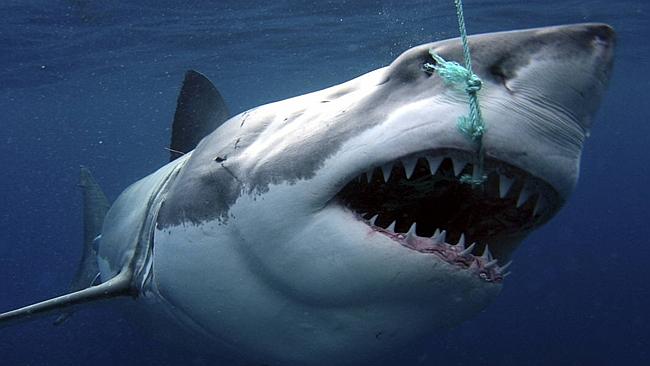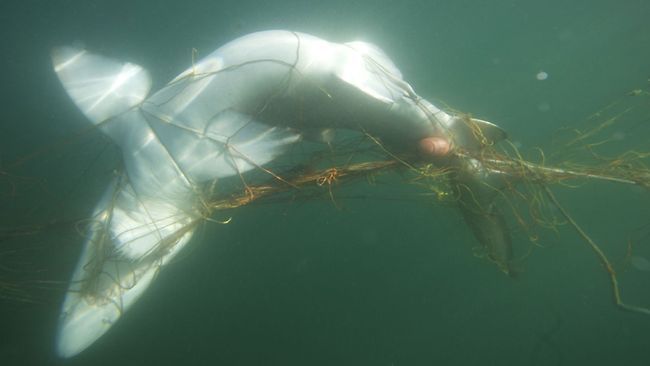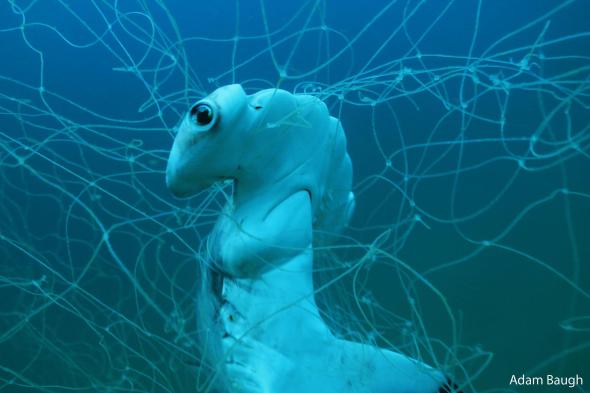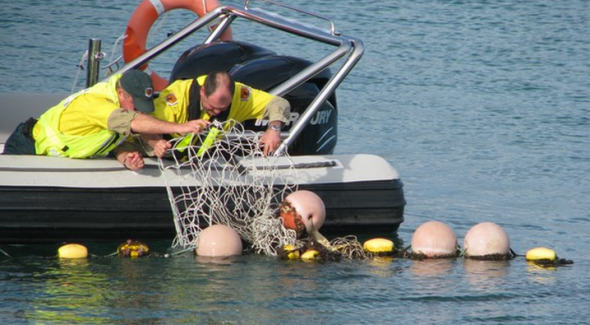Shark Net - The Cruel Practice of Shark Population Control.
SHARK NETS are causing quite a stir lately around the globe of which threatens the 350 species of shark globally. To date there are an (estimated) 300,000,000 sharks of which population declines have been rampant since the 1960’s. Fortunately Cites commonly known as the (Convention on International trade in Endangered Species of Wild Flora and Fauna) have implemented fishing bans on certain species of shark with regards to the copious levels of shark finning that has raged out of control this past two decades. Sharks and other marine life though are still evermore in danger, this time from negligent humans.
Shark populations have reduced from 70% in some species to up to 95% in other species in the last 15 years and one cannot place all blame on the finning trade though that is seen within Asia mostly used for fake medicine’s and broths.
1995 I witnessed sharks nets similar to the one pictured below around the beaches of Perth, Australia of which have been constructed in a way more or less to protect humans from being attacked by sharks coming to far inland, shark nets were placed into Australian oceans back in 1937. Problem is more sharks and endangered aquatic marine life are succumbing to death from human kindness and we are not talking a few hundred every year here. Many people believe that shark nets create an entire protective barrier thus keeping sharks away from humans. This is untrue, which leads bathers and surfers into a false sense of security. Sharks can swim over and under the nets which many people still to this very day seem completely oblivious too.
A shark net is a submerged net placed around beaches to reduce shark attacks on swimmers. Shark nets do not offer complete protection but work on the principle of “fewer sharks, fewer attacks“. They reduce occurrence via shark mortality. Reducing the local shark populations is believed to reduce the chance of an attack. The large mesh size of the nets is designed specifically to capture sharks and prevent their escape until eventually, they drown. Due to boating activity, the nets also float 4 metres or more below the surface and do not connect with the shoreline (excluding Hong Kong’s shark barrier nets) thus allowing sharks the opportunity to swim over and around nets.
Sadly it’s not just sharks that fall prey to shark nets, endangered species like sea turtles, dugongs, dolphins and whales have been pulled from shark nets around the world noted as (by-catch) of which reduces the aquatic populations furthermore. From 2011-2012 in Queensland there were some 700+ dead sharks pulled from nets, an estimated 200 of them were pulled two meters above in shark nets and drum lines.
Hong Kong-Australia and South Africa sees the vast majority of shark nets placed around the majority of public beaches. Australia has some 50+, Hong Kong in the region of 36 nets and South Africa (KwaZulu-Natal) it is estimated a further 38 public protection shark nets have been constructed. Florida, America has around 32 estimated shark nets situated around her shores of which(this is an estimated account).
Shark nets are not the only threat to sharks and marine life, drum lines are also causing quite a controversy within the conservation and animal welfare world and could be considered as the most cruel method of “keeping shark populations down”. Prior to 2014, drum lines were only utilised on Australia’s eastern coast and in South Africa where the numbers of shark attacks reduced dramatically. In 2014, the Western Australian government reacted to the loss of seven human lives in the years 2010-2013 and installed drum lines along around 200 km of its 20,000 km long coastline (around 1%). The policy has been the subject of national and international protests, coming under fire from marine conservationists and animal welfare advocates and their supporters. The policy is commonly referred to as the Western Australian shark cull. (Picture below depicts a dolphin caught in a shark net).
Shark attacks themselves are extremely rare compared to other types of deaths; between 2004 and 2008 there was an average of 4 fatal shark attacks recorded per year. Depending on their size, a minority of sharks survive being caught on a drum line. The combination of drum lines and shark nets do not directly lead to extinction, but they also may not give the population room to recover from being endangered of extinction. Drum lines are also responsible for by-catch, possibly including dolphins and sea turtles, both of which are fully protected in Australian waters. There is evidence of dolphins stealing bait on numerous occasions, thus rendering the drum lines useless.
Shark nets do not form a complete barrier and sharks can swim over, under or around the ends of the nets. Neither, of course, do drumlines form a physical barrier, so whilst we know this as do the African and Australian Environmental Agencies then why the need to implement such destructive nets is beyond rational thinking. Both shark nets and drumlines function by reducing shark numbers in the vicinity of protected beaches, thereby lowering the probability of encounters between sharks and people at those beaches.
The nets may have a limited physical barrier effect as well, but the fact that about 1/3 of the catch is caught on the shoreward side of the nets is evidence that such an effect is only partial. Drumlines are a recent introduction on the KwaZulu-Natal coast, but their so called successful use in Queensland, Australia, indicates that the fishing effect of the equipment is of primary importance.
It was recognised before shark netting was introduced in Sydney, Australia, in 1937 that only a complete enclosure would provide complete protection from shark attacks. Despite this, the safety record of shark nets off the coasts of New South Wales, Queensland (Australia) and KwaZulu-Natal has been very good. At Durban, from 1943 until the installation of nets in 1952, there were seven fatal attacks. Since the installation of nets there have been no fatalities at Durban and no incidents resulting in serious injury. At KwaZulu-Natal’s other protected beaches.
Picture depicts a baited hook drumline with great white hooked.
Shark attacks on swimming bathers are extremely rare, and its fact that you actually have more chance of being killed or seriously maimed sitting on the WC than one does of swimming within waters infested with sharks. There are of course many outspoken critics that will deny shark attacks are rare thus calling or supporting a nationwide cull.
Shark attack facts;
- 93% of shark attacks from 1580 to 2010 worldwide were on males.
- In 2010, North American Waters had 42% of all confirmed unprovoked attacks worldwide (32 attacks).
- Surfers accounted for 50.8% of all attacks in 2010.
- Swimmers and Waders accounted for 38% of all attacks in 2010.
- Snorkelers and divers accounted for 8% of all attacks in 2010.
- Inflatable rafts/inner tubes accounted for 3% of attacks in 2010.
- 2010 was the most dangerous year for unprovoked shark attacks in a decade with 79.
- Over the last half-century, there have been more unprovoked shark attacks in Florida (27 out of a total 139) between 2-3 pm than any other time of the day.
- New Smyrna Beach in Florida is the shark attack capital of the world according to ISAF. It is estimated that anyone who has swam there has been within 10ft of a shark.
- September is the month with the most Shark attacks in Florida (93) 1920-2010.
- Since 1907 201 out 220 Great White Attacks have occurred when the human was less than 6ft from the surface.
- You have a 1 in 63 chance of dying from the flu and a 1 in 3,700,000 chance of being killed by a shark during your lifetime.
- Over 17,000 people die from falls each year. That’s a 1 in 218 chance over your lifetime, compared to a 1 in 3,700,000 chance of being killed by a shark.
- In 1996, toilets injured 43,000 Americans a year. Sharks injured 13.
- In 1996, buckets and pails injured almost 11,000 Americans. Sharks injured 13.
- In 1996, 2600 Americans were injured by room fresheners. Sharks injured 13.
- The US averages just 19 shark attacks each year and one shark-attack fatality every two years. Meanwhile, in the coastal U.S. states alone, lightning strikes and kills more than 37 people each year.
- Since 1959, Florida has had more shark attacks (603) than lightning fatalities (459).
- Since 1959, California has had more shark attacks than lightning fatalities (89/30).
- Since 1959, Hawaii has had 97 Shark attacks but no lightning fatalities.
- Only 5 people die from shark attacks yearly, while millions of people die from starvation.
- For SAEL: Since 1905, Natal (where Durban is) has had 89 shark attacks and 27 fatalities.
- For every human killed by a shark, humans kill approximately two million sharks.
- Most shark attacks occur less than 100 feet from the shore mainly around popular beaches in North America (especially Florida and Hawaii), Australia, and South Africa.
- In 2008 a Polar bear Jaw was found in a Greenland Shark’s stomach.
- A whale shark can filter 1.5 million litres (400,000 gallons) of water an hour when feeding. That’s enough to supply 1,000 US homes for a day.
- Mathematicians figure you have about a one in a million chance of being bitten by a shark while swimming along the Florida beaches. (You probably have a better chance of being pooped on by a pelican.)
Since the 1930’s’s when shark nets were introduced to protect public bathers we have lost many hundreds of sharks, turtles, dugongs, and even dolphins and whales too. The time has come for these nets to be removed. Evidence has proved shark nets have “not stopped” human species conflict because sharks can swim around or under them. With such a vast decline of shark, turtle, and other endangered species then the time must come to get back to basics.
Declining species;
Shark control programs, as they are officially known, aim to reduce populations of great white sharks, tiger sharks and bull sharks, which are the species which pose the most threat to humans. In Queensland alone between 1975 and 2001, 11,899 great white sharks, tiger sharks and bull sharks were killed in shark nets and drum lines.
But shark nets are indiscriminate killers of other marine wildlife too as explained above. Some 53,098 other marine animals were also killed in nets and drumlines in Queensland, and the picture in NSW (New South Wales) is not much better. These animals included turtles, dugongs, whales, dolphins, rays and other harmless species of sharks such as the critically endangered grey nurse shark (pictured below the dugong). The NSW Government has even acknowledged this threat, recognising shark netting as a “key threatening process” under their environment law in 2003, following a scientific submission to Government by Humane Society International (HSI). Please donate to this wonderful organisation that is currently working to ban the pet meat trade in Thailand.
In Queensland the shark nets deployed in the water are 186 meters long and about 6 meters in height. They are not barriers to sharks, but designed to kill sharks of more than two meters in length (2009 study). They can therefore be likened to huge tennis nets — sharks can swim around or over the nets easily, but when swimming at pace are likely to not see them so get trapped and drown when they are no longer able to move and keep water flowing over their gills. Many people falsely believe that these nets stop sharks from swimming near beaches, giving beach-goers a false sense of security. Education is instead a key element of any protective strategy against shark encounters.
Most important to bear in mind is that the risk of shark encounters is extremely low risk. According to the Australian Shark Attack File in the last 50 years there have been 50 unprovoked shark attacks in Australia, averaging just one per year. In contrast 121 people drown each year at Australian beaches, harbours and rivers, and 60 people per year die from bee stings.
HSI has argued for many years that there is a better way. Shark nets were a solution implemented in the 1950s when our coastal waters were dirty and often contaminated with offal and blood from meatworks disposed of in our waterways. The situation is now much different and it is time to modernise our approach.
Since the 1950s our water quality has not only improved, but we have also amassed much more information about shark biology and their habits which can help inform our behaviour. For example, we know that when a school of bait fish are in an area they are likely to be followed by sharks who are feeding on those bait fish. At these times, it is wise to avoid swimming in the ocean as these sharks will be in a feeding frenzy. Many will also be familiar with the advice to avoid swimming at dusk and dawn when sharks are most likely to be feeding. Similarly, avoiding murky water, or areas known to be places frequented by large sharks, which may be breeding areas, is also good advice.
HSI is therefore urging the NSW and Queensland Governments to modernise their approach to protecting ocean users from the low risk of shark encounters, by removing shark nets and instead investing funds on educational awareness programs and further research on how best we can help avoid encounters with sharks.
South African Conservationists below practice a new safer alternative of shark netting. Will it reduce deaths though?
Non-shark species killed by shark nets;
Dolphins;
This month just gone (April 2014) sadly saw yet another dolphin indiscriminately killed when it swam into a shark net. A KAYAKER who witnessed a trapped baby dolphin dying in shark nets off Mooloolaba that Sunday morning has questioned the true value of the nets. Chris Finch admitted he was no expert on shark net operations, but seeing a baby dolphin dying virtually before his eyes has got him thinking.
“If they get stuck in the nets, they pretty much drown and die in their own environment,” he said.
Mr Finch was out for a morning paddle off the beach near the Loo with View, when he noticed what looked like an adult dolphin splashing near the nets. When he came closer, it swam away, but he realised the juvenile dolphin was trapped. “I pulled the net up to see if it could get out, by the time I got closer I saw it was not moving and it was dead,” he said.
Turtles;
Back in April 2013 turtles sparked the debate again on whether shark nets were really beneficial and exactly what use do they have preserving human life? Being cruel to be kind cannot any longer be seen as a “method” of conservation.
A TURTLE found dead in netting off Newcastle beach has sparked fresh concerns about shark prevention measures used along Hunter beaches. Linda Hall was entertaining friends and family on her boat just off the Bogey Hole that Sunday when the group came across what they thought was marine life in its natural environment.
However instead they were confronted with the distorted figure of a dead turtle that had been trapped in what Mrs Hall believes was shark netting. ‘‘We often sail round Broughton Island and we see turtles around there all the time but this was the first time I’d seen one tied in shark netting,’’ she said.
‘‘It was horrific; everyone on board was absolutely disgusted. To see such a beautiful creature in such a state was tragic.’ Surfrider Foundation of Australia Hunter branch president Chris Tola said from looking at the photo it appeared the turtle had been caught in shark netting. ‘‘Our stance is that there needs to be more research into shark nets,’’ he said.
A NSW Department of Primary Industries spokeswoman said it conducted its last check of shark nets on Monday and there were no reports of turtles caught in netting. She said while state government was committed to netting it was looking for ways to reduce the impact on other marine life.
Whale and dolphin alarms have been fitted to all nets to alert the animals and deter them.
Whales;
Back in October 2013 a hump back whale became yet another statistic of human negligence surrounding shark nets.
A spokeswoman from marine rescue group ORRCA said the group was called to Mona Vale beach around 7am (AEDT) on Tuesday. ORRCA vice-president Shona Lorigan said the whale was dead when NSW National Parks and Wildlife Service officers arrived around 10am (AEDT).
The parks and wildlife service will now determine how to remove the whale.The calf’s mother had been swimming nearby, responding to the baby’s distress calls.
Humane Society International spokeswoman Alexia Wellbelove said shark nets were “indiscriminate killers” of marine life and provided no real protection for humans. She said it was the first whale entanglement in NSW this year but urged more research into other possible shark deterrence methods. “This is a tragedy that we don’t want to see repeated,” she said. “We’re getting a growing number of entanglements each year.” Lorigan said dolphins and turtles also became entangled in shark nets.
Endangered species –
Back in October 2009 – a threatened species of the Dugong family was found dead in yet another shark net fatality.
An adult female dugong has been found dead in shark nets off a Sydney beach, leading to calls for the netting to be removed across the state.
NSW Industry and Investment said the mammal, more common in northern waters, was retrieved off Coogee Beach on Wednesday by the boat that checks nets after being spotted by a member of the public on Tuesday. The Nature Conservation Council of NSW said it was an adult female and its death would be significant to the slow reproducing species.
The dugong has now been taken to Sydney’s Taronga Zoo where an autopsy will be carried out to determine how it died. Greens MP Ian Cohen said the dugong had “drowned in the shark nets” and questioned why NSW persisted with netting beaches when it’s doing more harm than good.
“The announcement of a rare visit by a dugong to Sydney’s waters should be a happy occasion,” Mr Cohen said. “Dugongs were once thought by sailors to be mermaids.”These gentle herbivorous giants are on the brink of extinction and it is heart breaking to think that they ventured too close to foolish human activity and died,” he said.
A spokesperson from NSW Industry and Investment said the shark net program was about “striking a balance” that helps “minimise the risk of shark attacks, while at the same time reducing impacts on the environment.” But Mr Cohen said shark nets were even failing to provide adequate protection to swimmers, saying two shark attacks on NSW beaches last year occurred on meshed beaches.
He said shark nets killed 1,485 marine animals between 1995 and 2004. A Scientific Committee Report in 2003 also found at least six categories of vulnerable marine species were being caught in shark nets each year.
Seals;
Back on the 21st June 2012 seals became the next victim of shark nets;
Several calls were made to National Parks after walkers along Narooma’s Bar Beach and the break wall noticed a seal struggling in the shark net. Nearby was another dead seal that apparently drowned after becoming trapped in the shark net at least a day earlier. National Parks now says they were notified of the dead seal 24 hours prior to the calls about the live trapped seal on Thursday morning, and perhaps the live one became trapped while checking out the dead one.
National Parks rangers then boarded the Marine Rescue Narooma vessel to travel the short distance from its mooring down to the shark net at the entrance to Wagonga Inlet. Ranger in charge of Montague Island Ross Constable assisted by fellow ranger Andy Young leaned over the side of the boat and used a towel to cover the head of the distressed sub-adult fur seal while they cut it free. “It was on its last legs an exhausted,” Mr Constable said.
The animal once free was able to swim out the channel back out to sea and possibly the large colony on Montague Island. The rangers then moved on to the dead animal, which was also cut free and allowed to float away with the tide.
The rangers thanked the Marine Rescue unit for their assistance in the operation.
The Narooma News has reported on the growing numbers of seals at Montague Island this year, and seals hauling up and sunning themselves on the break wall rocks has become a more common sight in recent years. Eurobodalla Shire Council is in charge of maintaining the barrier net, known locally as the “shark net”, but there have been previous incidents of wildlife entrapment. Another seal had to be cut free by rangers when it became trapped in August 2009. The body of a seal was found in the shark net last winter, while a few years ago a large bronze whaler shark was also found dead inside the net.
The Narooma News has asked the council if the net’s maintenance program needs to be reviewed as a result of these latest entrapments, which seem more likely to happen when the net has been bunched up due to big seas and tides. A taut net seems less likely to trap wildlife.
Council’s manager of infrastructure Warren Sharpe said council inspected and maintained the net every three months using a diver. Works are also carried out when required, usually as a result of damage occurring from large seas and heavy swells. The incident relating to the whaler shark resulted from an already dead shark being placed within the netted area by persons unknown.
Mr Sharpe said council was only aware of two previous occasions when a seal became entangled in the shark net and both of these seals were dead, one already badly damaged and likely to have died at sea and been washed in. On those occasions the net was taught and in good order.Picture below depicts that of a seal being removed from shark netting.
But Mr Constable said National Parks rangers had been called in to release live seals as well as a live turtle. “From our point of view there will be increased instances of marine mammals and reptiles being caught in the net but it’s up to the council what happens to the net,” he said.
There had been a 2 to 3 per cent increase in fur seal numbers at Montague Island in recent years, according to seal expert Dr Peter Shaughnessy, however while the population was recovering from being hunted almost to extinction, the current numbers were still only one third to a half of the population prior to European settlement. National Parks was aware of increased interactions between humans and in particular fishers and the seals, and Mr Constable said an overt act to harm seals would not be tolerated and those caught could face fines worth thousands of dollars.
Alternatives to shark nets and drumlines;
Australia, United States of America, Japan and South Africa are now looking into alternatives that may see the original shark net replaced with a more eco-friendly barrier that has been developed in South Africa this past year.
Shark Safe was devised by Stellenbosch University scientists back in 2013 within South Africa. South African scientists, have developed an eco-friendly shark barrier which can be used as an alternative to a shark net. Positive results have been emerging of which needs to be taken on board by environmental departments around the globe sooner rather than later.
Professor Conrad Matthee, head of the Department of Botany and Zoology head of Shark Safe voiced concerns at the rapid decline in shark numbers of which he states some 90% declines have been seen in the past twenty years-of-which the majority of sharks seen in decline are that of the great white that’s known for its attacks on humans although rare.
The shark friendly barrier was developed primarily because we need to keep sharks and other apex predators within our delicate eco-system. Such extinctions of aquatic mega-fauna would be catastrophic which will no doubt disrupt the entire marine eco-system spelling furthermore species extinction and vast over-populations of others. The last thing needed right now is marine habitat fragmentation caused by altering humans.
The barrier is made of rigid upright pipes which resemble kelp when it floats in the water. The structure also contains magnets to make it effective for various shark species. The pipes are anchored to the seabed and stand upright to the height of the water level during high tide. A magnetic barrier that resembled kelp had been chosen because certain shark species, such as the Zambezi shark found in KwaZulu-Natal, were sensitive to strong permanent magnetic fields, while others, like the great white shark, did not like kelp at all.
Stellenbosch scientists stated “We, for instance, saw how seals chased by sharks swam into kelp and how the sharks, time and time again, turned away, not entering the kelp areas,” Matthee said. During research, the team put bait behind the barrier to attract sharks, but no sharks swam through the barrier. The sharks were also deterred by the magnetic fields, he said.
Concluding;
Just in New South Wales (NSW) some 4000 aquatic marine species have become entangled in shark nets in the past twenty years alone. Within the past twenty years it has been estimated that over 50,000 marine aquatic species have succumbed to shark nets and drumlines, the majority of these animals have all died from suffocation. Sharks, turtles, dugongs and other endangered sea creatures are already under threat from poaching, over fishing, habitat destruction, pollution, climate change and military sea operations. Least forgetting “shark nets and drumlines”.
Of the official count in (NSW) of 3944 creatures trapped, about 60 per cent were sharks and less than 4 per cent were considered ”target” species (or those particularly harmful to humans) - that is, 100 great whites and 49 tiger sharks. Among them were 15 grey nurses, a harmless species considered critically endangered. Also on the list were stingrays (1269), dolphins (52), turtles (47), whales (six), seals (four), a penguin and a dugong.
As environmentalists and animal welfare specialists we must now do more to push the governments concerned to take drastic action thus securing our marine life for the better. Failing this we will lose the majority of our 3000+ species of shark, one species of vulnerable dugong, eleven critically endangered species of turtle, Africans sea penguin, and countless other aquatic marine life.
Please contact your local environmental ministry, government president, marine environmental agencies and demand shark nets and drumlines are removed immediately with alternative tried and tested methods such as “Shark Safe” implemented today.
Thank you for reading;
Dr Josa Depre & J. Williamson
Chief Environmental Officer & Chief Environmental Officer Europa.
Environmental – Botanical – Zoological Sciences.
International Animal Rescue Foundation
Donate here today via our secure donate application or hereto via our main communications site.

